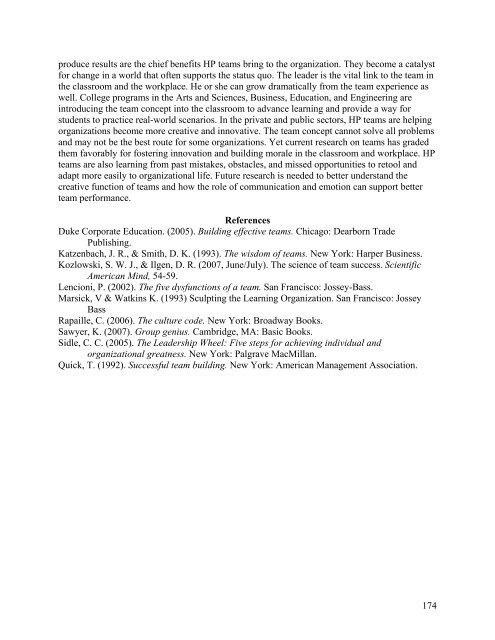2008 PROCEEDINGS - Public Relations Society of America
2008 PROCEEDINGS - Public Relations Society of America
2008 PROCEEDINGS - Public Relations Society of America
You also want an ePaper? Increase the reach of your titles
YUMPU automatically turns print PDFs into web optimized ePapers that Google loves.
produce results are the chief benefits HP teams bring to the organization. They become a catalyst<br />
for change in a world that <strong>of</strong>ten supports the status quo. The leader is the vital link to the team in<br />
the classroom and the workplace. He or she can grow dramatically from the team experience as<br />
well. College programs in the Arts and Sciences, Business, Education, and Engineering are<br />
introducing the team concept into the classroom to advance learning and provide a way for<br />
students to practice real-world scenarios. In the private and public sectors, HP teams are helping<br />
organizations become more creative and innovative. The team concept cannot solve all problems<br />
and may not be the best route for some organizations. Yet current research on teams has graded<br />
them favorably for fostering innovation and building morale in the classroom and workplace. HP<br />
teams are also learning from past mistakes, obstacles, and missed opportunities to retool and<br />
adapt more easily to organizational life. Future research is needed to better understand the<br />
creative function <strong>of</strong> teams and how the role <strong>of</strong> communication and emotion can support better<br />
team performance.<br />
References<br />
Duke Corporate Education. (2005). Building effective teams. Chicago: Dearborn Trade<br />
Publishing.<br />
Katzenbach, J. R., & Smith, D. K. (1993). The wisdom <strong>of</strong> teams. New York: Harper Business.<br />
Kozlowski, S. W. J., & Ilgen, D. R. (2007, June/July). The science <strong>of</strong> team success. Scientific<br />
<strong>America</strong>n Mind, 54-59.<br />
Lencioni, P. (2002). The five dysfunctions <strong>of</strong> a team. San Francisco: Jossey-Bass.<br />
Marsick, V & Watkins K. (1993) Sculpting the Learning Organization. San Francisco: Jossey<br />
Bass<br />
Rapaille, C. (2006). The culture code. New York: Broadway Books.<br />
Sawyer, K. (2007). Group genius. Cambridge, MA: Basic Books.<br />
Sidle, C. C. (2005). The Leadership Wheel: Five steps for achieving individual and<br />
organizational greatness. New York: Palgrave MacMillan.<br />
Quick, T. (1992). Successful team building. New York: <strong>America</strong>n Management Association.<br />
174
















